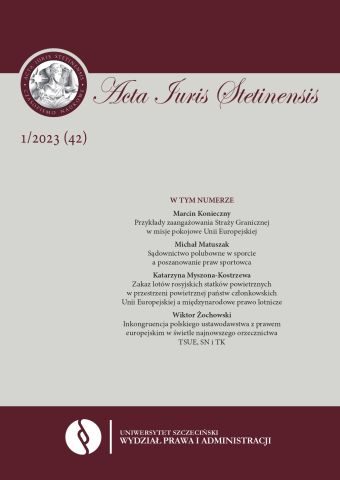







| Authors: |
Katarzyna
Myszona-Kostrzewa

Uniwersytet Warszawski |
| Keywords: | aviation law aircraft air carriers restrictive measures territory |
| Data publikacji całości: | 2023 |
| Page range: | 16 (97-112) |
| Downloads ?: | 112 |
| 1. | Berezowski C., Międzynarodowe prawo lotnicze, Warszawa 1964. |
| 2. | Berezowski C., Prawo międzynarodowe publiczne, Warszawa 1969. |
| 3. | Brownlie I., Principles of Public International Law, Oxford 1990. |
| 4. | Diederiks-Verschoor I.H.Ph., Butler M.A., An introduction to Air Law, Boston 2006. |
| 5. | Dzienkiewicz W., w: M. Żylicz (red.), Prawo lotnicze. Komentarz, Warszawa 2016. |
| 6. | Jennings R., Watts A. (red.), Oppenheim’s International Law, London–New York 1992. |
| 7. | Kunert-Diallo A., Żylicz M., Potrzeba zmian w prawie lotniczym (wnioski po katastrofie smoleńskiej), „Państwo i Prawo” 2012, nr 4. |
| 8. | McClean J.D., Balfour J.M., Gardiner R.K., Goh J., Margo R.D. (red.), Shawcross and Beaumont, Air Law, London 2010. |
| 9. | Myszona-Kostrzewa K., Pojęcie i status prawny państwowego statku powietrznego na podstawie konwencji chicagowskiej z 1944 r., w: Z. Galicki, T. Kamiński, K. Myszona-Kostrzewa (red.), Manfred Lachs – wybitny prawnik świata, Warszawa 2011. |
| 10. | Myszona-Kostrzewa K., w: M. Żylicz (red.), Prawo lotnicze. Komentarz, Warszawa 2016. |
| 11. | Słok-Wódkowska M., Umowy regulujące transport lotniczy – praktyka UE i państw członkowskich, w: Z. Galicki, T. Kamiński, K. Myszona-Kostrzewa (red.), 40 lat minęło – praktyka i perspektywy Konwencji Wiedeńskiej o prawie traktatów, Warszawa 2009. |
| 12. | Żylicz M., Prawo lotnicze międzynarodowe, europejskie i krajowe, Warszawa 2011. |